General Info
Major cities
General information about Egypt
Visas:
 All nationalities require tourist visas for Egypt. Europeans, Americans, Australians and Canadians can purchase these on arrival at the airport other nationalities should check with their local Embassies for latest regulations.
All nationalities require tourist visas for Egypt. Europeans, Americans, Australians and Canadians can purchase these on arrival at the airport other nationalities should check with their local Embassies for latest regulations.![]()
Language:
![]() The national language in Egypt is Arabic. However, tourists will rarely find a problem communicating in English whereby English language is widely spoken in hotels and shops.
The national language in Egypt is Arabic. However, tourists will rarely find a problem communicating in English whereby English language is widely spoken in hotels and shops.![]()
Time zone:

Egypt is two hours ahead of GMT (Greenwich Mean Time).

![]()
Temperature:
![]() Local daytime temperatures range as follows for the year (°C):
Local daytime temperatures range as follows for the year (°C):
| Jan | Fed | Mar | Apr | May | Jun | Jul | Aug | Sep | Oct | Nov | Dec | ||
| Cairo | High | 19 | 21 | 24 | 28 | 32 | 35 | 35 | 35 | 32 | 30 | 24 | 21 |
| Low | 9 | 9 | 11 | 14 | 17 | 18 | 22 | 22 | 20 | 18 | 14 | 11 | |
| Luxor | High | 23 | 25 | 29 | 35 | 40 | 41 | 41 | 41 | 39 | 35 | 30 | 25 |
| Low | 5 | 7 | 11 | 16 | 21 | 23 | 24 | 24 | 22 | 18 | 12 | 8 | |
| Aswan | High | 24 | 30 | 35 | 39 | 42 | 41 | 41 | 41 | 36 | 30 | 25 | 25 |
| Low | 8 | 9 | 13 | 17 | 21 | 24 | 24 | 25 | 22 | 9 | 14 | 10 | |
| Sharm El- Sheikh |
High | 23 | 26 | 29 | 33 | 36 | 34 | 34 | 34 | 33 | 28 | 23 | 23 |
| Low | 16 | 17 | 18 | 21 | 24 | 26 | 27 | 27 | 26 | 23 | 20 | 16 | |
Electricity:
![]() Egypt electrical current is 220V, and sockets take the standard continental EUROPEAN dual round-pronged plug.
Egypt electrical current is 220V, and sockets take the standard continental EUROPEAN dual round-pronged plug.![]()
Currency:
![]() The local currency is the Egyptian pound, or 'LE', which is divided into 100 pilasters. At the moment, USD 1.00 is worth around LE 6.00.
The local currency is the Egyptian pound, or 'LE', which is divided into 100 pilasters. At the moment, USD 1.00 is worth around LE 6.00.![]()
Photography:
 If you are taking a picture of local people, always ask their permission beforehand. Your guide can assist you in this. Do not take pictures of military installations or airports. pictures or camera fees are applicable at most sights and museums your guide can give you details of the latest charges.
If you are taking a picture of local people, always ask their permission beforehand. Your guide can assist you in this. Do not take pictures of military installations or airports. pictures or camera fees are applicable at most sights and museums your guide can give you details of the latest charges.![]()
Dress Code:
 Egypt is a country very used to tourists, and for sightseeing in popular areas such as the Pyramids or the main sights of Upper Egypt, shorts and T-shirts is fine. However, you should allow for a more conservative dress code when walking in central Cairo and other cities, and especially in rural areas. When visiting mosques or other religious sites, casual, comfortable clothing covering knees and elbows is best, in order to respect the local culture. Around the pool at your hotel or on a cruise, low necklines, sleeveless shirts, or shorts can be comfortably worn; and at the beach in Red Sea resorts, feel free to dress as you would at home.
Egypt is a country very used to tourists, and for sightseeing in popular areas such as the Pyramids or the main sights of Upper Egypt, shorts and T-shirts is fine. However, you should allow for a more conservative dress code when walking in central Cairo and other cities, and especially in rural areas. When visiting mosques or other religious sites, casual, comfortable clothing covering knees and elbows is best, in order to respect the local culture. Around the pool at your hotel or on a cruise, low necklines, sleeveless shirts, or shorts can be comfortably worn; and at the beach in Red Sea resorts, feel free to dress as you would at home.
![]()
Health:
 No vaccinations are currently needed for visitors to Egypt. During your stay, it is preferable to drink only bottled water and to avoid eating from street stalls. Take care from the sun, which can often feel cooler than it really is due to the cool coastal breezes and lack of humidity. Drink plenty of water when staying outside during the day.
No vaccinations are currently needed for visitors to Egypt. During your stay, it is preferable to drink only bottled water and to avoid eating from street stalls. Take care from the sun, which can often feel cooler than it really is due to the cool coastal breezes and lack of humidity. Drink plenty of water when staying outside during the day.![]()
Tipping:
 It's customary to tip often in Egypt and you may want to think about carrying small bills in your pocket for this purpose. Visitors would normally consider tipping their Egyptologist tour guide, drivers, hotel staff, cruise staff , waiters in restaurants and porterage in airports and hotels.
It's customary to tip often in Egypt and you may want to think about carrying small bills in your pocket for this purpose. Visitors would normally consider tipping their Egyptologist tour guide, drivers, hotel staff, cruise staff , waiters in restaurants and porterage in airports and hotels.![]()
Leisure & Corporate Travel special services
 Please note that all needed documents, vouchers and domestic airline tickets are going to be with our representatives who will assist you in the check-in and out of all hotels, cruise and airports.
Please note that all needed documents, vouchers and domestic airline tickets are going to be with our representatives who will assist you in the check-in and out of all hotels, cruise and airports.
![]() Please note that several of the above information could be changed without prior notice.
Please note that several of the above information could be changed without prior notice.
The most important touristic cities in Egypt
Cairo
 was founded in the year 969 A.D. making it 1,042 years old. Nicknamed "The City of a Thousand Minarets" for its preponderance of Islamic architecture, Cairo has long been a centre of the region's political and cultural life. Cairo was founded by the Fatimid dynasty in the 10th century AD.; but the land composing the present-day city was the site of national capitals whose remnants remain visible in parts of Old Cairo. Cairo is also associated with Ancient Egypt due to its proximity to the ancient cities of Memphis, Giza and Fustat which are nearby to the Great Sphinx and the pyramids of Giza.
was founded in the year 969 A.D. making it 1,042 years old. Nicknamed "The City of a Thousand Minarets" for its preponderance of Islamic architecture, Cairo has long been a centre of the region's political and cultural life. Cairo was founded by the Fatimid dynasty in the 10th century AD.; but the land composing the present-day city was the site of national capitals whose remnants remain visible in parts of Old Cairo. Cairo is also associated with Ancient Egypt due to its proximity to the ancient cities of Memphis, Giza and Fustat which are nearby to the Great Sphinx and the pyramids of Giza.
Egyptians today often refer to Cairo as Masr (Arabic: مصر), the Arabic pronunciation of the name for Egypt itself, emphasizing the city's continued role in Egyptian influence. Cairo has the oldest and largest film and music industries in the Arab World, as well as the world's second-oldest institution of higher learning, al-Azhar University. Many international media, businesses, and organizations have regional headquarters in the city, and the Arab League has had its headquarters in Cairo for most of its existence.
With a population of 6.76 million spread over 453 square kilometers (175 sq mi), Cairo is by far the largest city in Egypt. With an additional ten million inhabitants just outside the city, Cairo resides at the centre of the largest metropolitan area in Africa and the eleventh-largest urban area in the world.[6] Cairo, like many other mega-cities, suffers from high levels of pollution and traffic, but its metro – the only one on the African continent until the Algiers Metro began service on November 1, 2011 – also ranks among the fifteen busiest in the world,[7] with over 700 million passenger rides annually. The economy of Cairo was ranked first in the Middle East, and 43rd globally by Foreign Policy's 2010 Global Cities Index
.![]()
Alexandria
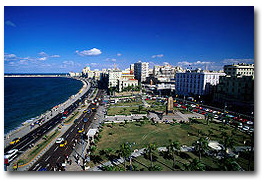 Alexandria (Arabic: الإسكندرية Al Iskandariyya,, Greek: Αλεξάνδρεια Alexándria, Koine Greek: λεξάνδρεια κατ' Αγυπτον, Alexandria is the second-largest city of Egypt, with a population of 4.1 million, extending about 32 km (20 mi) along the coast of the Mediterranean Sea in the north central part of the country; it is also the largest city lying directly on the Mediterranean coast. It is Egypt's largest seaport, serving approximately 80% of Egypt's imports and exports. Alexandria is also an important tourist resort. It is home to the Bibliotheca Alexandrina (the new Library of Alexandria). It is an important industrial centre because of its natural gas and oil pipelines from Suez.
Alexandria (Arabic: الإسكندرية Al Iskandariyya,, Greek: Αλεξάνδρεια Alexándria, Koine Greek: λεξάνδρεια κατ' Αγυπτον, Alexandria is the second-largest city of Egypt, with a population of 4.1 million, extending about 32 km (20 mi) along the coast of the Mediterranean Sea in the north central part of the country; it is also the largest city lying directly on the Mediterranean coast. It is Egypt's largest seaport, serving approximately 80% of Egypt's imports and exports. Alexandria is also an important tourist resort. It is home to the Bibliotheca Alexandrina (the new Library of Alexandria). It is an important industrial centre because of its natural gas and oil pipelines from Suez.
Alexandria was founded around a small pharaonic town c. 331 BC by Alexander the Great. It remained Egypt's capital for nearly a thousand years, until the Muslim conquest of Egypt in AD 641, when a new capital was founded at Fustat (Fustat was later absorbed into Cairo). Alexandria was known because of its Lighthouse of Alexandria (Pharos), one of the Seven Wonders of the Ancient World; its library (the largest library in the ancient world); and the Catacombs of Kom el Shoqafa, one of the Seven Wonders of the Middle Ages. Ongoing maritime archaeology in the harbor of Alexandria, which began in 1994, is revealing details of Alexandria both before the arrival of Alexander, when a city named Rhacotis existed there, and during the Ptolemaic dynasty.
From the late 19th century, Alexandria became a major centre of the international shipping industry and one of the most important trading centres in the world, both because it profited from the easy overland connection between the Mediterranean Sea and the Red Sea, and the lucrative trade in Egyptian cotton.
![]()
Luxor
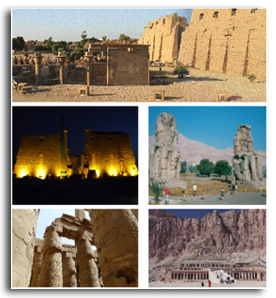 Luxor (Arabic: أَلْأُقْصُر Al 'Uqsur) is a city in Upper (southern) Egypt and the capital of Luxor Governorate.
Luxor (Arabic: أَلْأُقْصُر Al 'Uqsur) is a city in Upper (southern) Egypt and the capital of Luxor Governorate.
The population numbers 487,896 (2010 estimate), with an area of approximately 416 square kilometres (161 sq mi).
As the site of the Ancient Egyptian city of Thebes, Luxor has frequently been characterized as the "world's greatest open air museum", as the ruins of the temple complexes at Karnak and Luxor stand within the modern city.
Immediately opposite, across the River Nile, lie the monuments, temples and tombs on the West Bank Necropolis, which include the Valley of the Kings and Valley of the Queens.
Thousands of international tourists arrive annually to visit these monuments, contributing a large part towards the economy for the modern city. ![]()
Aswan
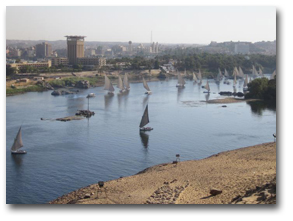 Aswan ( Arabic: أسوان Aswān, Ancient Egyptian: Swenet, Coptic: Swān, Ancient Greek: Συήνη Syene), formerly spelled Assuan, is a city in the south of Egypt, the capital of the Aswan Governorate.
Aswan ( Arabic: أسوان Aswān, Ancient Egyptian: Swenet, Coptic: Swān, Ancient Greek: Συήνη Syene), formerly spelled Assuan, is a city in the south of Egypt, the capital of the Aswan Governorate.
Aswan is a busy market and tourist centre located just north of the Aswan Dams on the east bank of the Nile at the first cataract.
The modern city has expanded and includes the formerly separate community on the island of Elephantine.
Aswan is the ancient city of Swenet, which in antiquity was the frontier town of Ancient Egypt facing the south. Swenet is supposed to have derived its name from an Egyptian goddess with the same name[citation needed]. This goddess later was identified as Eileithyia by the Greeks and Lucina by the Romans during their occupation of Ancient Egypt because of the similar association of their goddesses with childbirth, and of which the import is "the opener". The ancient name of the city also is said to be derived from the Egyptian symbol for trade.
Because the Ancient Egyptians oriented toward the origin of the life-giving waters of the Nile in the south, Swenet was the first town in the country, and Egypt always was conceived to "open" or begin at Swenet.[citation needed] The city stood upon a peninsula on the right (east) bank of the Nile, immediately below (and north of) the first cataract of the flowing waters, which extend to it from Philae. Navigation to the delta was possible from this location without encountering a barrier.
![]()
Sharm el-Sheikh
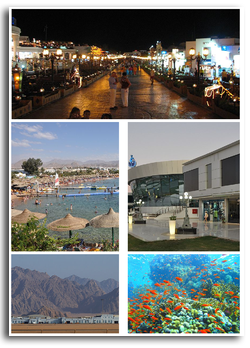 Sharm el-Sheikh (Arabic: شرم الشيخ, Sharm al-Shaykh, pronounced is a city situated on the southern tip of the Sinai Peninsula, in South Sinai Governorate, Egypt, on the coastal strip along the Red Sea.
Sharm el-Sheikh (Arabic: شرم الشيخ, Sharm al-Shaykh, pronounced is a city situated on the southern tip of the Sinai Peninsula, in South Sinai Governorate, Egypt, on the coastal strip along the Red Sea.
Its population is approximately 35,000 (2008).
Sharm el-Sheikh is the administrative hub of Egypt's South Sinai Governorate which includes the smaller coastal towns of Dahab and Nuweiba as well as the mountainous interior, Saint Catherine's Monastery and Mount Sinai.
Sharm el-Sheikh city together with Naama Bay, Hay el Nour, Hadaba, Rowaysat, Montazah and Shark's Bay form a metropolitan area.
Before 1967 Sharm el-Sheikh was little more than an occasional base of operations for local fishermen; the nearest permanent settlement was in Nabk, north of Ras el-Nasrani ("The Tiran Straits"). Commercial development of the area began during the Israeli presence in the area. The Israelis built the town of Ofira, overlooking Sharm el-Maya Bay and the Nesima area, and opened the first tourist-oriented establishments in the area 6 km north at Naama Bay. These included several hotels on the southern side of the bay, a nature field school on the northern side, diving clubs, a now well-known promenade.
After Sinai was restored to Egypt in 1982 the Egyptian government embarked on an initiative to encourage continued development of the city. Foreign investors – some of whom had discovered the potential of the locality during the Israeli occupation – contributed to a spate of building projects. Environmental zoning laws currently limit the height of buildings in Sharm el-Sheikh so as to avoid obscuring the natural beauty of the surroundings.
![]()
Hurghada
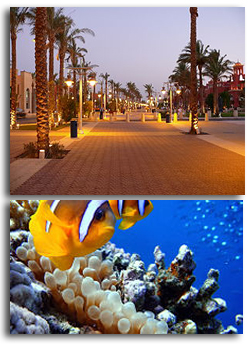 The city was founded in the early 20th century, and since the 1980s has been continually enlarged by Egyptian and foreign investors to become the leading seashore resort on the Red Sea. Holiday villages and hotels provide aquatic sport facilities for sailboarders, yachtsmen, scuba divers and snorkelers.
The city was founded in the early 20th century, and since the 1980s has been continually enlarged by Egyptian and foreign investors to become the leading seashore resort on the Red Sea. Holiday villages and hotels provide aquatic sport facilities for sailboarders, yachtsmen, scuba divers and snorkelers.
Hurghada stretches for about 36 kilometres (22 mi) along the seashore, and it does not reach far into the surrounding desert. The resort is a destination for Egyptian tourists from Cairo, the Delta and Upper Egypt, as well as package holiday tourists from Europe, notably Serbs, Italians, Russians, Poles, Czechs and Germans. Until a few years ago it was a small fishing village. Today Hurghada counts 248,000 inhabitants and is divided into three parts: Downtown (El Dahar) is the old part; Sekalla is the city center, and El Memsha (Village road) is the modern part. Sakalla is the relatively modest hotel quarter.
Dahar is where the town's largest bazaar, the post office and the long-distance bus station are situated.
The city is served by the Hurghada International Airport with scheduled passenger traffic to and from Cairo and direct connections with several cities in Europe. The airport has undergone massive renovations to accommodate rising traffic. Hurghada is known for its watersports activities, nightlife and warm weather. Daily temperature hovers round 30 degrees celsius most of the year.![]()
